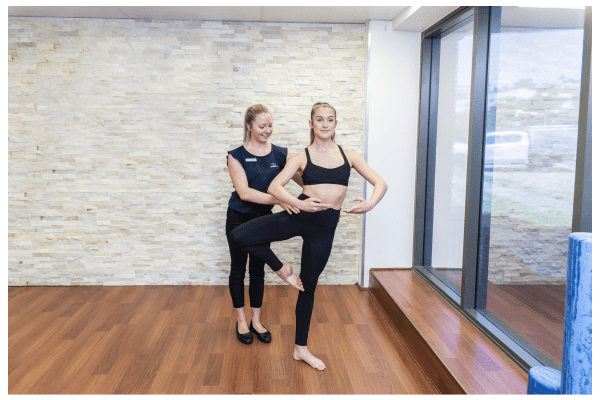There are many things that can cause tension and decreased flexibility in the body. Quite often dancers will feel tension in their back or legs prior to class, however stretching these areas for long periods before you dance is not the answer. Prolonged stretching can decrease the ability of that muscle to work when you begin class, which increases your chance of injury. So how do you relieve this tension?
First you need to work out what could be causing the restriction.
Nerve irritation, compression of a joint, fascial tightness and muscle trigger points are all potential causes of tightness before class. Each one has very different needs in terms of how to release them so it’s important to know the difference.
It’s important to get to class 5-10minutes early so you can prepare your body for warm up. The best self-assessment for how your body is feeling on the day is a roll down. Stand with knees straight or very gently bent, tuck chin to chest and slowly roll down, one vertebrae at a time. As you roll down, identify points of tightness or restriction in your body. Take note of the feeling as this gives you the biggest clues to what is causing that tightness!

Here is how to tell the difference:
- A thin line of tension tends to indicate nerve tension.
- A flat area of tension or a wider area of tension tends to indicate fascial tension
- A focused point or area usually indicates muscle tension.
- If it feels like a pressure on the closing side of a joint this is likely irritation of the joint
What to do once you’ve worked out the cause of your tension…
Nerve tension
Note the point where you first felt the restriction. Then lie down and either using a tennis ball or foam roller gently release the muscles at the base of the skull (sub occipitals). This needs to be done very gently with NO PAIN. If you have trouble releasing this area yourself, you can get someone else to very gently massage it for you. Then re-test your roll down. You should find that your range is a lot better!
Unsure about where to massage? Or if it doesn’t work for you, chat with your Physio about how to release your sub occipitals effectively.
Fascial Tension
Fascia has many long connections throughout the body. It attaches, stabilizes, encloses, and separates muscles and other internal organs. In order for us to stay mobile and flexible our fascia has to stay hydrated. As we move through flowing movement our fascia reorganizes itself to accommodate our movement. The mobility of fascia is extremely important for anyone that wants to improve their range of motion and flexibility. If you feel like your fascia is restricting your movement fascial mobilisers will get rid of this restriction. Fascial mobilisers are nice slow/long movements in multiple directions to stretch along the length of your body. It is important that you feel a reach at the end of each of these movements however you do not hold them. The flowing movement allows water to rush in and hydrate the fascia. If you hold the movements, you will not allow the fluid to hydrate the fascia which is what facilitates the increase in your movement. Pop on over to our Insta or Facebook accounts to see videos of some fascial flows.
Muscle Tension
A focused point of tension tends to be tightness or a trigger point in a muscle. To release this, you’ll need a decent quality tennis ball. You can either lie down, with the ball on the area of tension or lean up agains the wall. Roll the ball around until you find the tender spot, then pause in that location. Think about melting that spot like butter. You don’t need to apply lots of pressure to the area. Just imagine melting away. Once that spot softens, roll the ball around and release any other tender spots you find in that area.
Joint Irritation
This is a harder one to fix on your own. If you are experiencing joint irritation, I’d highly recommend going to see a Physiotherapist so that you can sort out the cause as early as possible. There are usually technique refinements, muscle imbalances, and flexibility issues that will need to be addressed to resolve this, and there is no one size fits all solution. Joint irritation can lead to many issues that can prevent you dancing long term, therefore it’s safest to get it looked at as early as possible.
Bear in mind that the cause of pre class tension may change from day to day, depending on what you’ve done before class or the day before. Make sure you check your roll down first, identify the cause of your restriction, then address that restriction. Then re-check your roll down to make sure that the tension has gone before you start your class warm up.
– Jaquie Goldsack, Physiotherapist
If you would like to make an appointment with Jaquie, give one of our friendly staff a call on 4724 0768 or follow the link to book online. https://physionorth.bookings.pracsuite.com


